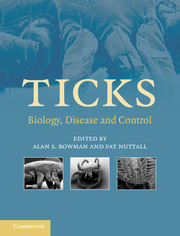Book contents
- Frontmatter
- Contents
- List of contributors
- Preface
- 1 Systematics and evolution of ticks with a list of valid genus and species names
- 2 The impact of tick ecology on pathogen transmission dynamics
- 3 Tick salivary glands: the physiology of tick water balance and their role in pathogen trafficking and transmission
- 4 Tick saliva: from pharmacology and biochemistry to transcriptome analysis and functional genomics
- 5 Tick toxins: perspectives on paralysis and other forms of toxicoses caused by ticks
- 6 Tick lectins and fibrinogen-related proteins
- 7 Endocrinology of tick development and reproduction
- 8 Factors that determine sperm precedence in ticks, spiders and insects: a comparative study
- 9 Tick immunobiology
- 10 Saliva-assisted transmission of tick-borne pathogens
- 11 Lyme borreliosis in Europe and North America
- 12 Viruses transmitted by ticks
- 13 Babesiosis of cattle
- 14 Theileria: life cycle stages associated with the ixodid tick vector
- 15 Characterization of the tick–pathogen–host interface of the tick-borne rickettsia Anaplasma marginale
- 16 Emerging and emergent tick-borne infections
- 17 Analysing and predicting the occurrence of ticks and tick-borne diseases using GIS
- 18 Acaricides for controlling ticks on cattle and the problem of acaricide resistance
- 19 Anti-tick vaccines
- 20 Anti-tick biological control agents: assessment and future perspectives
- 21 Pheromones and other semiochemicals of ticks and their use in tick control
- Index
9 - Tick immunobiology
Published online by Cambridge University Press: 21 August 2009
- Frontmatter
- Contents
- List of contributors
- Preface
- 1 Systematics and evolution of ticks with a list of valid genus and species names
- 2 The impact of tick ecology on pathogen transmission dynamics
- 3 Tick salivary glands: the physiology of tick water balance and their role in pathogen trafficking and transmission
- 4 Tick saliva: from pharmacology and biochemistry to transcriptome analysis and functional genomics
- 5 Tick toxins: perspectives on paralysis and other forms of toxicoses caused by ticks
- 6 Tick lectins and fibrinogen-related proteins
- 7 Endocrinology of tick development and reproduction
- 8 Factors that determine sperm precedence in ticks, spiders and insects: a comparative study
- 9 Tick immunobiology
- 10 Saliva-assisted transmission of tick-borne pathogens
- 11 Lyme borreliosis in Europe and North America
- 12 Viruses transmitted by ticks
- 13 Babesiosis of cattle
- 14 Theileria: life cycle stages associated with the ixodid tick vector
- 15 Characterization of the tick–pathogen–host interface of the tick-borne rickettsia Anaplasma marginale
- 16 Emerging and emergent tick-borne infections
- 17 Analysing and predicting the occurrence of ticks and tick-borne diseases using GIS
- 18 Acaricides for controlling ticks on cattle and the problem of acaricide resistance
- 19 Anti-tick vaccines
- 20 Anti-tick biological control agents: assessment and future perspectives
- 21 Pheromones and other semiochemicals of ticks and their use in tick control
- Index
Summary
INTRODUCTION
Understanding of the tick–host–pathogen interface has increased dramatically in recent years and will continue to benefit from tick salivary gland transcriptome analysis, proteomics, functional genomics and the first tick genome project. Ticks modulate host haemostasis, pain/itch responses, wound healing and immune defences (Wikel, 1996, 1999; Schoeler & Wikel, 2001; Brossard & Wikel, 2004; Nuttall & Labuda, 2004). Salivary gland genes responsible for these activities are being identified (Valenzuela, 2004; Ribeiro et al., 2006; Alarcon-Chaidez, Sun & Wikel, 2007). Pharmacologically active compounds have been identified in insect and tick salivary glands and their biological activities established (Ribeiro, 1995a, b, 2004; Steen, Barker & Alewood, 2006). In addition to facilitating blood-feeding, these molecules are increasingly recognized as important factors in transmission and establishment of tick-borne infectious agents (Schoeler & Wikel, 2001; Brossard & Wikel, 2004). The biological activities of these molecules can be exploited for development of novel vector and transmission blocking vaccines. Characterizing the immunobiology of the dynamic interactions of the tick–host–pathogen interface is important for understanding infectious agent transmission, innate and specific acquired immune responses developed to the vector and to the pathogen, and for vaccine design. In the following sections, we address current knowledge in key aspects of tick immunobiology.
- Type
- Chapter
- Information
- TicksBiology, Disease and Control, pp. 186 - 204Publisher: Cambridge University PressPrint publication year: 2008
- 16
- Cited by



